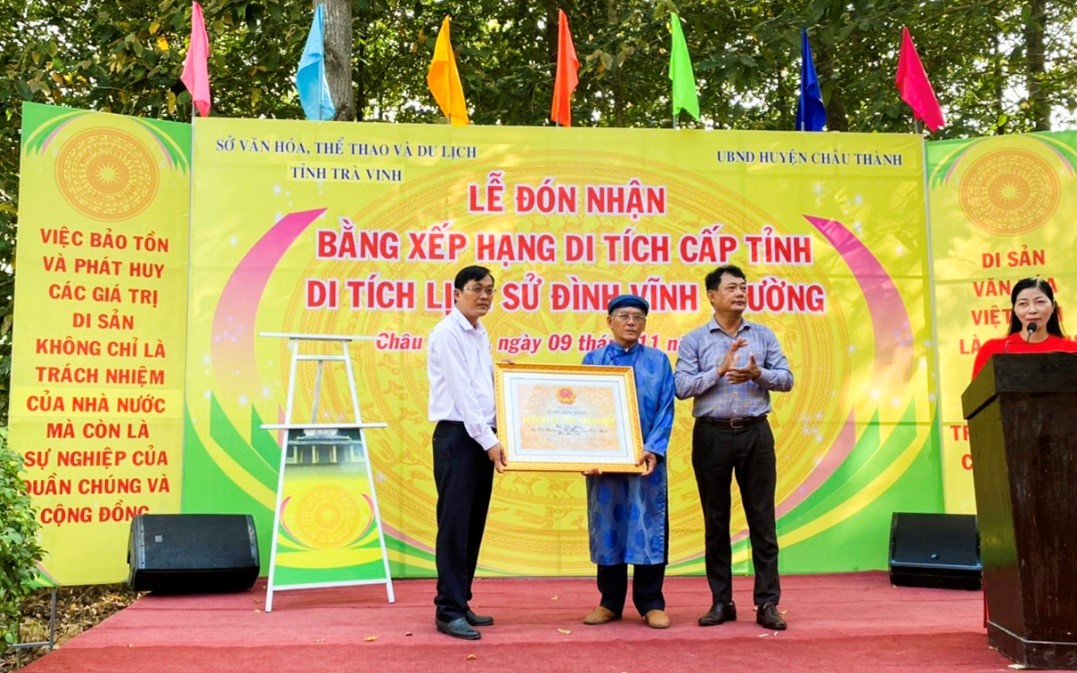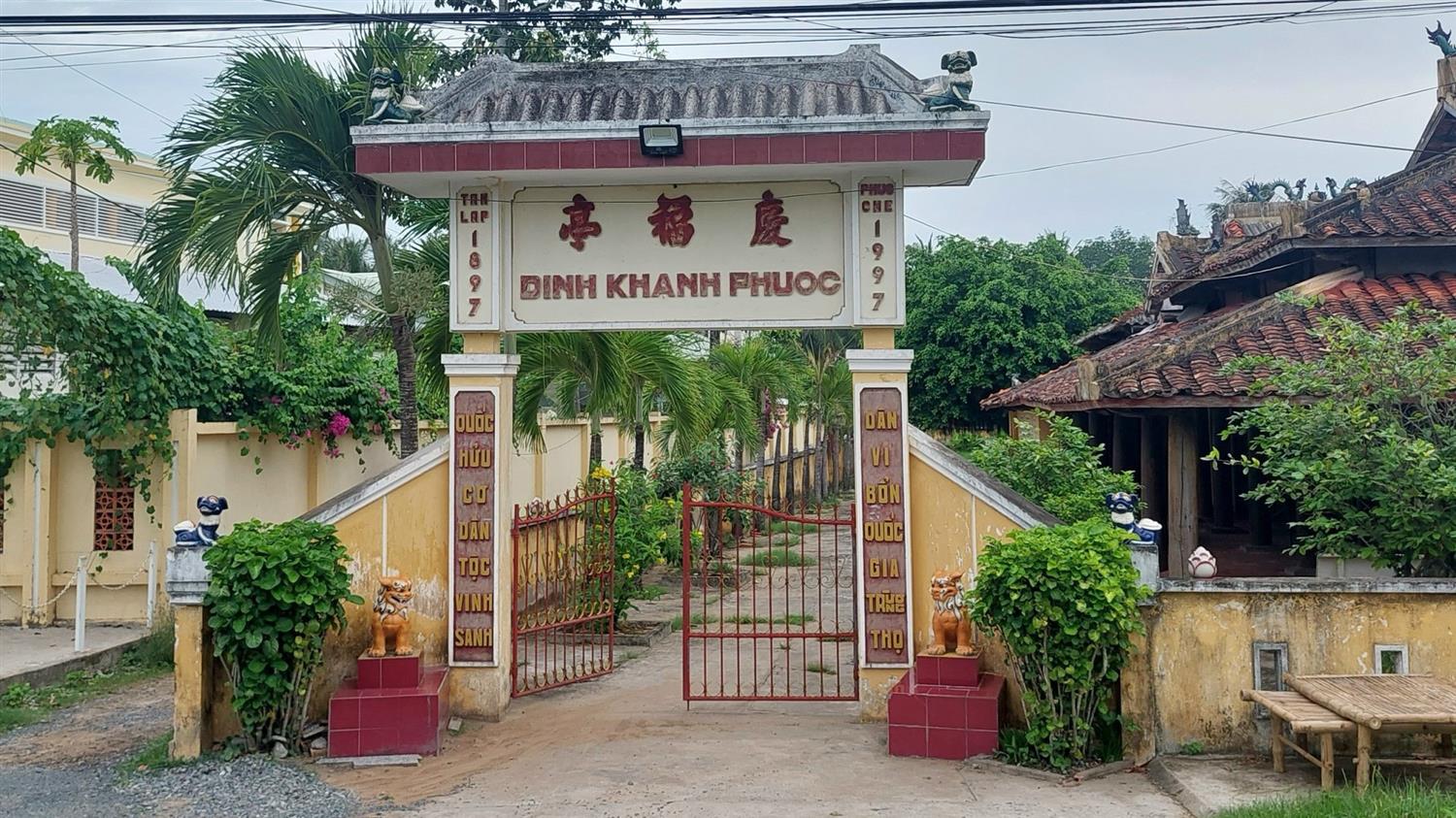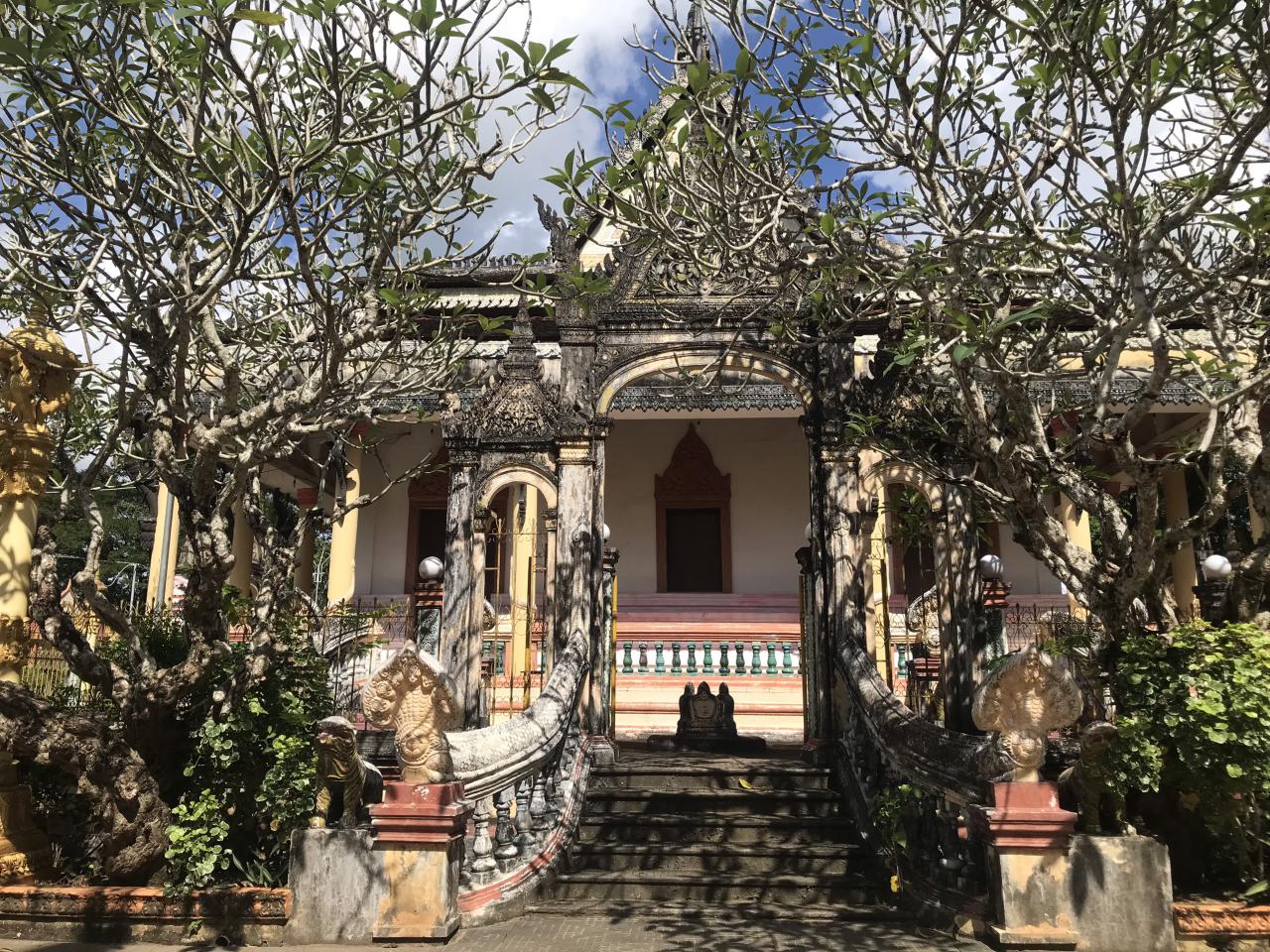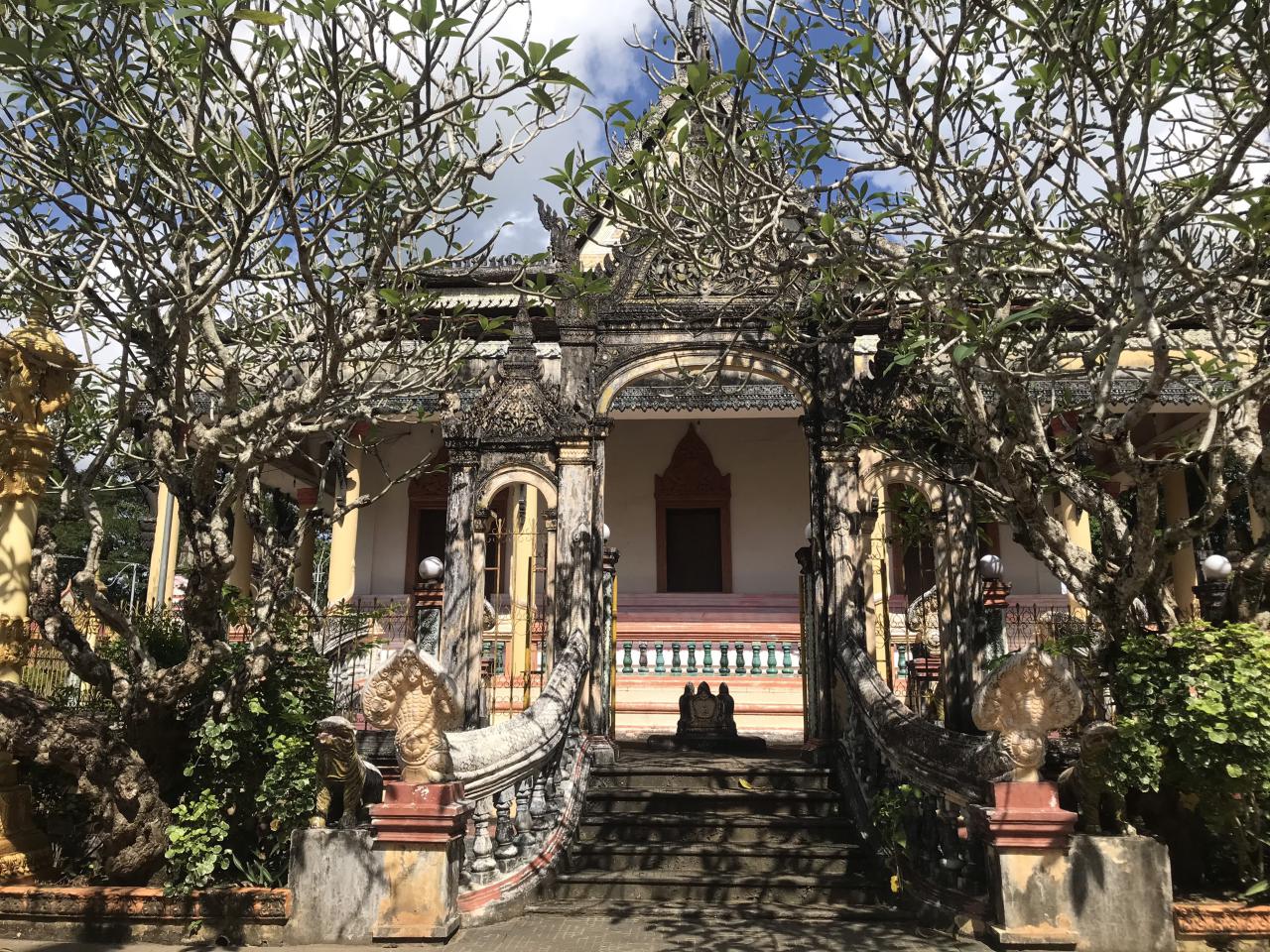Cổ Tông Miếu (Ancient Ancestral Temple)
Cổ Tông Miếu is situated in Khóm 2, Châu Thành town, Châu Thành district, Trà Vinh province. It is located approximately 7 kilometers south of Trà Vinh city.
According to an inscribed stone tablet preserved at Cổ Tông Miếu, although the characters on the stone have faded, it is still possible to decipher some of the characters, including “己巳” (Kỷ Tỵ), which, according to the temple’s elderly, corresponds to the year 1869. Considering the period of migration of the Chinese Triều Châu people to the Châu Thành area, it can be concluded that Cổ Tông Miếu was built around this time, more than 150 years ago.
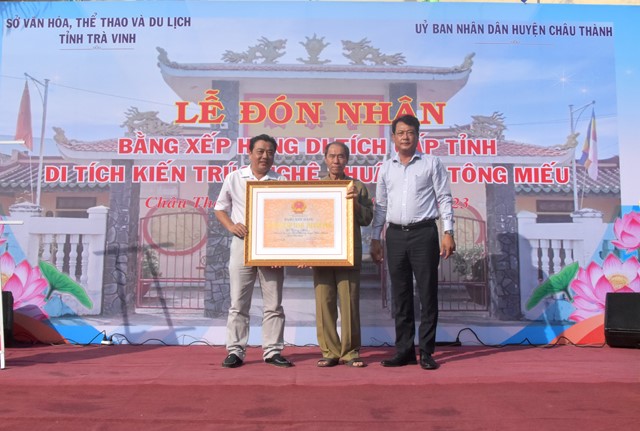
When first constructed, the temple was extremely simple, consisting of columns and thatched roofing. In 1940 (Canh Thìn), the Cổ Tông Miếu management committee undertook significant renovations to expand and solidify the temple, shaping it into the architectural form we see today.
Cô̕ Tông Miếu covers an area of 210.91 square meters with the front side facing east. The overall layout consists of three parallel structures: the front hall, central hall, and main hall, forming a “三” (three) shape. Flanking these structures are the eastern and western long houses, which, along with the three main structures, enclose a tranquil courtyard. From the exterior to the interior of the monument, unique carved and ornamental artwork can be found throughout, expressing the cultural nuances of the Chinese community.
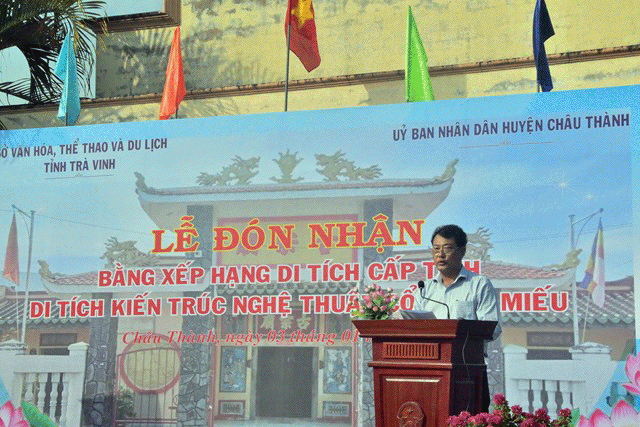
The main facade of the temple features three doors: one leading to the worship hall and two on either side entering the eastern and western long houses. Inside the front hall, two opposite doors connect to the eastern and western long houses, forming a closed quadrangle. The temple roof is designed in a tiered, boat-shaped curve with green glazed tiles. The load-bearing structure is made of wood.
The interior of the temple is adorned with intricately carved and uniquely decorated elements, such as screens, altars, lintels, paired columns, bas-reliefs, plaques, and exquisite paintings. Notably, a distinctive decorative style is expressed through carved wooden panels with diverse motifs, ranging from animals and flowers to mythical creatures, trigrams, and other elements, all crafted through intricate carving techniques to create exquisite and refined artworks.
Altars are decorated with images of dragons, qilins, phoenixes, and various plant elements, meticulously carved and painted with vibrant colors. Red is the predominant color in the temple’s interior, signifying prosperity, wealth, and happiness in Chinese culture. The exterior of the temple is adorned with a golden background, symbolizing nobility and grandeur.
Gate Fence: The temple’s gate fence was rebuilt in 2002 using reinforced concrete and tiled roofs in a fish-scale pattern. The fence is designed in a radial pattern with square columns, a roofed entrance, and a pair of stone lions guarding the entrance. Above the gate, a stone plaque inscribed with the Hán script “古宗廟” (Cô̕ Tông Miếu) in red on a gold frame. The gate has square pillars, and there is a roof above it. On the roof, there are two dragons chasing a pearl, and the eaves are decorated with dragon-head motifs and meandering cloud patterns.
Front Courtyard: The front courtyard of the temple is beautifully decorated. The walls are adorned with intricate bas-reliefs and wall paintings. These paintings depict symbols of happiness, such as lychee, plum, and cherry blossoms, reflecting wishes for good health and luck. On the left side of the courtyard, there are four deity figures: Lý Thiết Quài carrying a shackle, Lam Thái Hòa holding a basket of flowers, Tào Quốc Cựu with a jade scroll, and Hà Tiên Cô bearing a lotus. On the right side, there are four deities: Hàn Tương Tử playing a flute, Hán Chung Ly with a fan, Lã Đồng Tân with a fluttering flag and a sword, and Trương Quả Lão holding a fan. These depictions symbolize longevity and immortality.
Adjacent to these is a painting labeled “進禄” (Advancing Prosperity), showing an official dressed in blue and a lady in red facing another couple dressed in red, symbolizing prosperity.
Villa Wall: The temple’s villa wall features a rounded beast with a lion’s mane, a lion’s head, a cow’s tail, and ornate hoof feathers, with four claws on each foot. The creature’s face is rotated 90 degrees from the body’s axis, with a short mouth and short fangs, and it lacks horns. The surroundings feature natural scenes and tree leaves with cloud patterns, adding a sense of sanctity to the mythical creature. The other side of the wall displays an image of an elephant on grass, surrounded by natural elements, with pine trees expressing the desire for a prosperous life.
The temple doors are made of wood, with two door panels portraying the deities Môn thần Tần Thúc Bảo in red on the left wing and Uất Trì Cung in black on the right wing, both carrying a halberd and armored to protect the temple with grandeur and solemnity.
Upon entering the temple, above, in the middle of two columns at the front hall, there is a wooden horizontal lacquered board with four golden Chinese characters on a black background: 北 極 威 靈 (Northern Pinnacle Mighty Spirit). On the left side, there is an inscription: 甲 寅 年 秋 吉 立 (Year Giap Dần, in the autumn month, fortunate erection – Erection in the autumn of the Giap Dần year 1914). On the right side, there is an inscription: 沐 恩 胡 門 信 女 張 德 壽 酧 謝 (Bathing in the grace of the Hồ family, trustworthy daughter Trương Đức Thọ repays the favor – The Hồ family’s trustworthy daughter, Trương Đức Thọ, repays the favor).
On the columns of the front hall, there are two pairs of Chinese couplets:
1. 往 事 昭 昭 億 萬 世 長 傳 宇 宙 (The past is brilliantly passed down through countless ages, reaching throughout the universe).
2. 精 忠 耿 耿 千 百 年 猶 在 人 (Loyalty and sincerity remain undiminished, for a thousand, a hundred years, still in the hearts of people).
The front hall has two doors that lead to the East and West wings. Above the door leading to the East wing, there is an inscription: 民 康 – 咸 沾 (People’s well-being – All-encompassing). Above the door leading to the West wing, there is an inscription: 安 寧 – 物 阜 (Peace – Abundance). These inscriptions express blessings for the prosperity and tranquility of the people.
Each of the door wings leading to the East and West wings is intricately decorated with unique artistic motifs, such as birds, flowers, bamboo, and plum blossoms, symbolizing good luck and happiness. In woodcarving art, bamboo and plum blossoms are considered symbols of good fortune and happiness.
The interior of Cổ Tông Miếu is further adorned with two rows in the East and West wings, the main entrance, and the major deities’ altars. It showcases detailed carvings and unique artistic elements, ranging from depictions of nature to mythical creatures. Each wood-carved piece is a testament to the artistry and rich cultural heritage of the Chinese people.
The main hall, known as Chính điện, is the most important part of the temple. It houses the altars of various deities, including Quan Công and Bắc Đế, along with various other deities. These deities represent unwavering faith, embodying the hopes and dreams of the Chinese community in Châu Thành, ensuring their prosperity and success in life.
Woodcarvings within Chính điện also include images of books, which are part of the Eight Precious Objects, symbolizing good fortune and a peaceful soul. Images of flowers and birds, mythical creatures, and decorative patterns of leaves, platters, vases, and other elements are intricately and exquisitely carved into the wood. Additionally, detailed carvings of the mythical creature Kỳ Lân, as well as elephants on grass, and the symbol of pine trees, representing an aspiration for prosperity and longevity, decorate the temple walls.
The main hall features four square wooden columns, adorned with four Chinese couplets carved into the wood:
1. 道 本 玄 通 總 攝 雲 源 歸 静 穆 (The Way is mysterious and inclusive, it brings all under the quietness of the tranquil origin).
2. 魔 凴 武 伏 還 將 生 氣 寓 威 嚴 (Evil bows to might, and vitality will be guided by the majestic spirit).
3. 先 武 穆 而 神 大 漢 千 古 大 宋 千 古 (Before the Wu Dynasty, the awe-inspiring spirit of the great Han and the great Song last forever).
4. 後 文 宣 而 聖 山 東 一 人 山 西 一 人 (After the Wu Dynasty, only one person in the east, and one person in the west of the sacred mountain).
The interior of Cổ Tông Miếu also features two side wings, Đông lang and Tây lang, each adorned with wooden doors and woodcarvings of heavenly maidens, dragons, and phoenixes in the Four Supernatural Creatures set. The door handles are shaped like fierce lion heads, exuding protection and power.
The wooden doors leading to the East wing are adorned with the Chinese characters: 光 明 紫 極 (Bright, purples heights – Illuminating the heavens). The door leading to the West wing features the characters: 明 珠 普 照 (Bright pearl, universal shine – Illuminating the world). These inscriptions bless those who enter and exit the temple.
Cổ Tông Miếu is a significant religious site for the Chinese community, serving as a historical and cultural landmark in Châu Thành, and a testament to the region’s rich history and cultural fusion as it welcomed people from various ethnic backgrounds.
Through the historical site of Cổ Tông Miếu, we come to understand the distinctive elements of culture, particularly in architectural heritage, cultural festivals, and the religious belief system of the Chinese people in general and the Chinese community in Trà Vinh in particular. This temple is not merely a sacred space for worshipping deities but also an architectural masterpiece, preserving unique traditional artworks that carry the rich cultural heritage of the Chinese people.
Cổ Tông Miếu serves as a destination for the public to explore, study, and learn about Chinese culture. It is a hub for activities and educational initiatives that deeply connect the community through various religious practices and temple festivals. These festivals provide an opportunity for people to come together, enjoy, bond, share values between individuals and the community, fostering a strong sense of unity and togetherness.
Cổ Tông Miếu plays a significant role in facilitating cultural understanding, education, and community engagement, allowing for the continuation of cultural traditions and the harmonious coexistence of people from various backgrounds.
